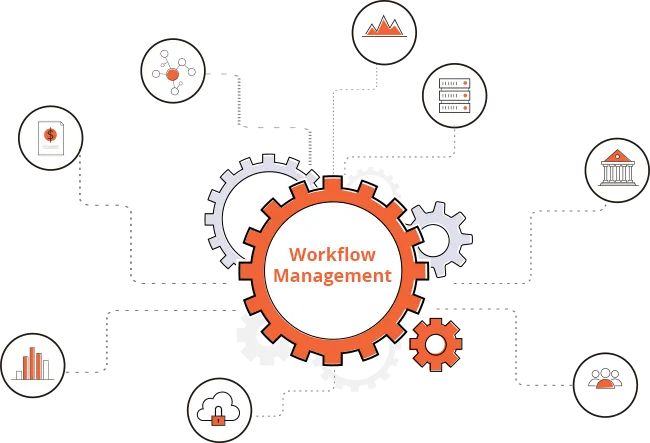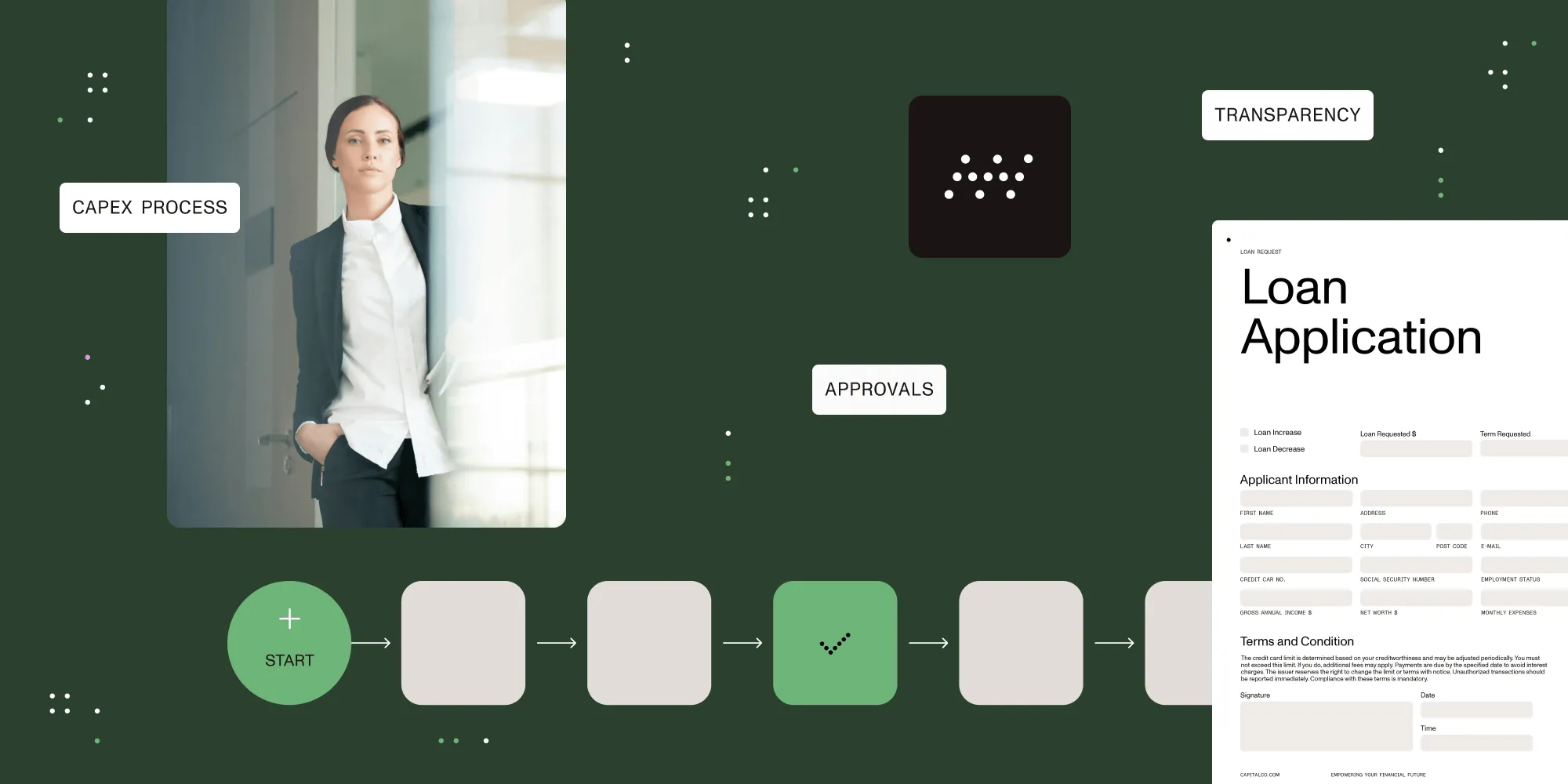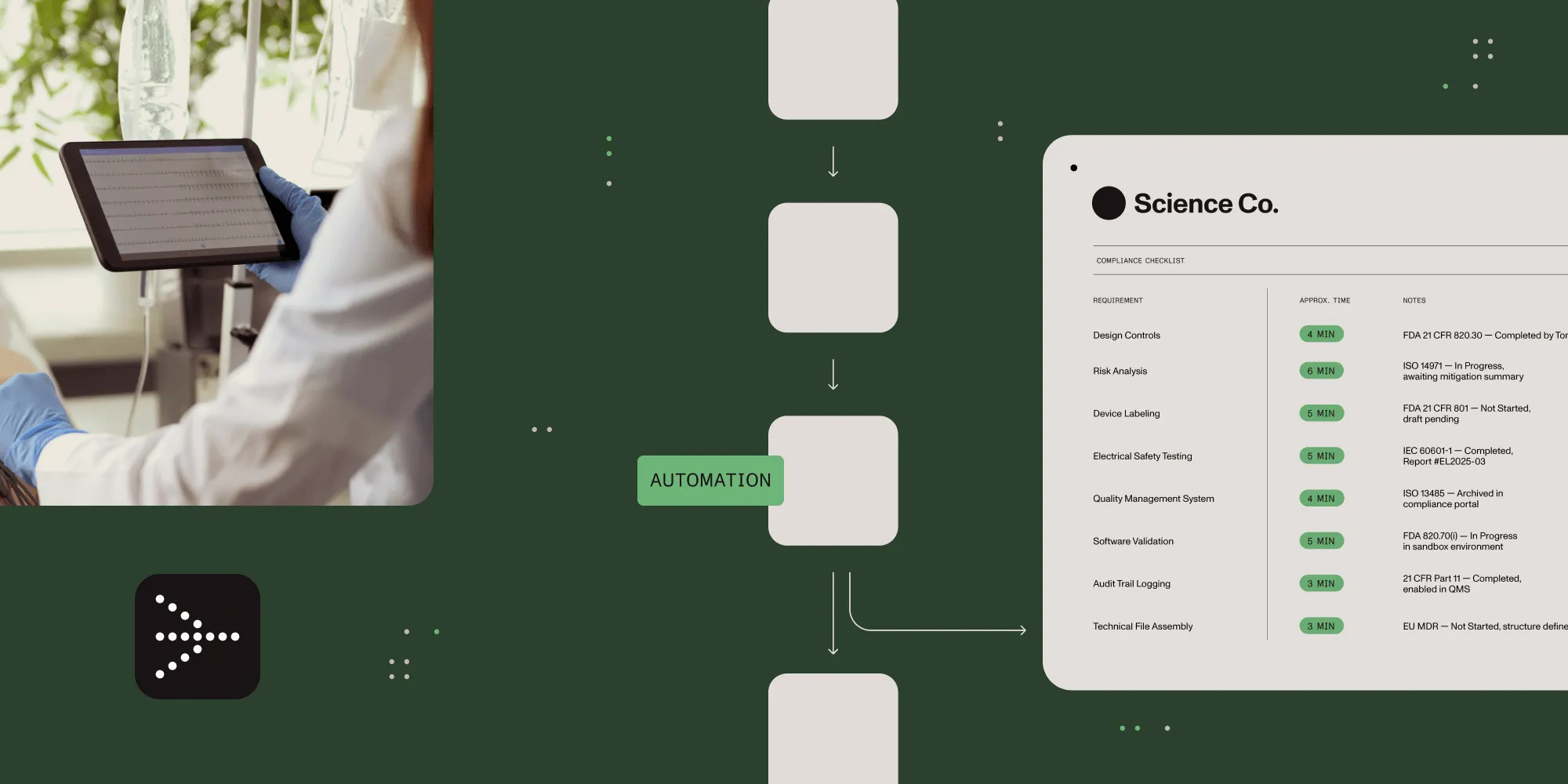Workflow management software solutions

Definition
Workflow management software defines, automates, and improves an organization's business processes to improve efficiency, reduce errors, and increase productivity. For more on workflow systems, visit this article on Wikipedia(opens in a new tab).
What is Workflow Management?
Every company uses various workflows to ensure tasks are completed and business goals are reached. These workflows(opens in a new tab) and processes require much human intervention to keep the workflow moving forward. This could mean emails, pop-ins, meetings, calls, Slack messages, etc. This manual workflow leads to mistakes, long turnaround times, non-compliance, and other issues.

Implementing workflow automation and management depends on your business, tools, and unique challenges. However, generally speaking, workflow management solutions can be thought of as identifying, improving, and automating the various processes that ensure your team accomplishes the work it needs to get done. Automated processes can be tracked and evaluated more readily than manual ones, leading to new insights and improvements.
In summary, managing your organization's workflow means
- Documenting
- Automating
- Improving
Let's get started with a few examples of effective workflow systems.
Examples
Every organization and every department has its use cases for workflow solutions. For instance, Finance might need to automate expense requests, while HR might need to automate employee onboarding workflow. Meanwhile, IT might need a system to handle cybersecurity incident management. Each of these workflows is different, with different forms, routing, logic, etc. Each department uses a different workflow system at some companies, leading to disparate and disconnected organizational workflow.
Here are some examples of departmental workflow management use cases.
| IT/IS | Finance | Marketing |
|---|---|---|
| IT Service Requests | CapEx/AFE Requests | Campaign Approvals |
| Security Access Requests | Expense Approvals | Collateral Approvals(opens in a new tab) |
| New Account Setup | Salary/Wage Changes | Brand Management |
| Change Requests | AP Automation | |
| New Project Requests | Grant Management | |
| Security Incidents |
| HR | Purchasing | |
|---|---|---|
| Benefits Changes | Procurement Process | |
| Timesheets | Capital Approvals | |
| New Hire Management | Vendor Management | |
| Employee Onboarding | Invoice Approvals | |
| Employee Offboarding | Product Pricing | |
| Vacation Requests |
| Facilities | Sales | Legal |
|---|---|---|
| Office Relocations | Quote Approvals | Legal Holds |
| Office Automation | Pricing Discounts(opens in a new tab) | Contract Reviews |
| Resource Scheduling | Proposal Approvals | Client Intake |
| Facility Access | Product Discounts | |
| Move Requests |
For detailed examples of where and how tools like Nutrient Workflow can be used to manage your workflow, visit our Workflow Examples page or download our Workflow Use Case Examples PDF.
Point solutions attempt to handle departmental workflow needs like onboarding employees, managing invoices, etc. However, some organizations find that implementing a workflow platform that is department-agnostic and flexible while remaining accessible enough for business users to use easily is a better way to go. Administrators and business users can customize workflows over time to improve efficiency or adapt to changing needs.
Video: How does workflow management software work?
Benefits of Workflow Tools
At the end of the day, why do companies invest in workflow software to replace manual processes?
Here are a few benefits you can count on:
- Streamline and speed up internal processes by reducing manual entry and request handling.
- Reduce errors and re-work.
- Reduce the risk of improperly approved requests, contracts, hires, etc.
- Improve compliance with audit trails.
- Increase output and increase productivity.
- Provide a unified, personalized request experience for employees.
- Track request status (completed, pending, or in progress, etc.) in real-time
- Identify performance trends (group and individual) over time.
- Reduced license overhead for enterprise systems (ERP, CRM, etc.)
- Monitor team progress against Service Level Agreements.
- Identify and remove process barriers or bottlenecks.
- Better align tasks with the skillsets and assign tasks to the most appropriate staff members.
- Drastically reduce paperwork and associated costs and waste.
- Reduce the need for manual decision-making and handling of business rules.
- Identify redundancies and improve process efficiency.
- Switch from single to parallel processing of tasks.
- Eliminate circumvention of organizational business rules.
- Provide staff members with reminders and alerts when tasks age.
- Allow for 24/7 access to approve and monitor requests and tasks.
- Allow staff and management to focus on value-added projects and tasks.
How Are Workflow Systems Typically Implemented?
Workflow management software can be deployed to suit the requirements of the organization. For instance, we offer cloud-based SaaS, private cloud, or on-premise versions of Nutrient Workflow so you can meet any organizational or regulatory standards as required. We'll help you get up and running no matter what version you choose, and all versions have the same features and workflow tools.
A typical deployment includes a best-practice project management framework with our service teams, which you can read more about here. Our service and implementation team are experienced and focused on quickly getting you up and running. We also provide ongoing coaching and training as needed.
The process for rolling out an automated workflow to a department or organization typically looks like this:
- Gather information about the workflows to be managed and automated.
- Document the workflow details, including forms, hand-offs, routing, etc.
- Illustrate the process using a flowchart or workflow design tool.
- Gain consensus on the workflow from all stakeholders.
- Build the workflow and forms within a workflow software tool.
- Perform user acceptance testing with a pilot group of users to ensure accuracy.
- Train end-users on how to use the new system.
- Launch the new system.
For more on implementing a new workflow, check out our blog.
 Workflow Management begins with drag-and-drop process building.
Workflow Management begins with drag-and-drop process building.
Workflow Integration Options
Vendors have different approaches to integration. Here are a few that you're likely to run across:
- The solution will integrate exclusively with enterprise applications like Microsoft SharePoint or specific HRIS systems.
- The solution will integrate with a handful of enterprise applications based on limited partner relationships with those vendors.
- The solution will provide an open system with standalone Web services that allow process integration with almost any scenario. Some custom work may be required.
- The solution will offer various integrations through middleware like Zapier or Mulesoft.
- The solution will provide pre-built connectors with specific applications.
Pricing Options
The way workflow management systems are priced varies among vendors. The most common scenario is subscription-based pricing. You pay for a set number of users who can access the system. This may be broken into tiers like "View Only," "User," and "Administrator," where each user tier is progressively more expensive.
Another scenario is paying the vendor based on the number of transactions. So, for instance, a workflow that involves a public-facing component like insurance claims would generate a large number of transactions and pricing would be dependent on volume.
The last scenario we'll discuss here (although there are myriad options) is a "Per Process" option. In this situation, you pay the vendor for each process you build. This could be a tiered structure where you pay X amount for five processes, X amount for ten processes, etc.
Nutrient Workflow User License Options
To simplify administration, an Nutrient Workflow “user” is anyone who logs into Nutrient Workflow, whether an administrator building workflows or someone completing tasks in the system. For even more flexibility, you can choose the type of user license that makes sense.
Named Users
You decide who can access the system, and each user gets their login and password. Named allows X users to log in to submit requests, complete tasks, run reports, or be administrators.
Concurrent Users
Everyone in your organization can log in to the system, but only a certain number can be on the system simultaneously. We can guide a realistic number of concurrent users based on your organization’s size.
Additional Workflow Management Software Resources
- Detailed Definition (Wikipedia)(opens in a new tab)
- Gartner Definition(opens in a new tab)
- Questions to ask a Workflow Management Software Vendor
- Workflow Examples
- Workflow Automation Guides
- Best Workflow Management Software Vendors
Interested in Automating Your Workflow?
We have various resources to help you navigate an automated workflow.
- Workflow Management Tools and eBooks
- Workflow Ideas Weekly Email Newsletter(opens in a new tab)
- Recorded Demonstration of our Workflow Management Software
- Request a Live Demonstration
FAQ
What is workflow management software?
Workflow management software helps define, automate, and improve business processes, increasing efficiency and reducing errors.
How does workflow automation benefit organizations?
Automation streamlines tasks, reduces manual effort, enhances compliance, and improves overall productivity and task tracking.
Can workflow management systems be customized?
Yes, most systems allow customization to fit specific business needs, such as forms, routing, and logic adjustments.
What are common pricing models for workflow management tools?
Pricing can be subscription-based, transaction-based, or per process, often with different user tiers or license options.
What integration options are available for workflow systems?
Workflow tools may offer integration with enterprise apps, open Web services, middleware, or pre-built connectors.







